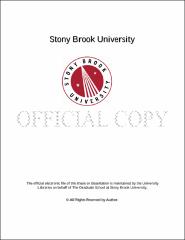| dc.identifier.uri | http://hdl.handle.net/11401/77050 | |
| dc.description.sponsorship | This work is sponsored by the Stony Brook University Graduate School in compliance with the requirements for completion of degree. | en_US |
| dc.format | Monograph | |
| dc.format.medium | Electronic Resource | en_US |
| dc.language.iso | en_US | |
| dc.publisher | The Graduate School, Stony Brook University: Stony Brook, NY. | |
| dc.type | Dissertation | |
| dcterms.abstract | DNA interstrand crosslinks (ICLs) are DNA lesions that covalently link two strands of a DNA duplex, thereby acting as a block to DNA replication and transcription. As a result ICLs are particularly toxic to dividing cells, and ICL-forming agents such as cisplatin, nitrogen mustards and MMC are widely used in cancer chemotherapy. However, there are complex cellular pathways that repair ICLs, contributing to the problem of resistance to these anti-tumor agents. There appear to be multiple ICL repair pathways operating in cells but the majority of ICLs in vertebrates are repaired in a replication-coupled manner. A key step in this repair pathway is the unhooking of the ICL from one of the strands by nucleases, followed by translesion synthesis across the unhooked ICL by DNA polymerases. The structure of the unhooked ICL substrate determines key outcomes such as efficiency and fidelity of the repair process. However the position of incisions by nucleases and the structure of unhooked ICL substrates are not known. Using a strategy developed in our laboratory, I synthesized structurally diverse model unhooked ICLs to investigate the effect of ICL structure on the approach, insertion and extension abilities of replicative and TLS polymerases. I demonstrated that the distortion induced in the duplex by the crosslink, as well as the duplex context of the ICL are important factors that influence the nature of translesion synthesis by DNA polymerases. Surprisingly, I found that the most processed form of an ICL – a single crosslinked base that is believed to be a putative intermediate during ICL repair – can be bypassed by replicative polymerases and that ICLs may be repaired without the help of TLS polymerases in some cases. This work provides insight into how structures of unhooked ICLs influence biological outcomes such as occurrence of resistance and secondary tumor formation during the translesion synthesis step in ICL repair. | |
| dcterms.abstract | DNA interstrand crosslinks (ICLs) are DNA lesions that covalently link two strands of a DNA duplex, thereby acting as a block to DNA replication and transcription. As a result ICLs are particularly toxic to dividing cells, and ICL-forming agents such as cisplatin, nitrogen mustards and MMC are widely used in cancer chemotherapy. However, there are complex cellular pathways that repair ICLs, contributing to the problem of resistance to these anti-tumor agents. There appear to be multiple ICL repair pathways operating in cells but the majority of ICLs in vertebrates are repaired in a replication-coupled manner. A key step in this repair pathway is the unhooking of the ICL from one of the strands by nucleases, followed by translesion synthesis across the unhooked ICL by DNA polymerases. The structure of the unhooked ICL substrate determines key outcomes such as efficiency and fidelity of the repair process. However the position of incisions by nucleases and the structure of unhooked ICL substrates are not known. Using a strategy developed in our laboratory, I synthesized structurally diverse model unhooked ICLs to investigate the effect of ICL structure on the approach, insertion and extension abilities of replicative and TLS polymerases. I demonstrated that the distortion induced in the duplex by the crosslink, as well as the duplex context of the ICL are important factors that influence the nature of translesion synthesis by DNA polymerases. Surprisingly, I found that the most processed form of an ICL – a single crosslinked base that is believed to be a putative intermediate during ICL repair – can be bypassed by replicative polymerases and that ICLs may be repaired without the help of TLS polymerases in some cases. This work provides insight into how structures of unhooked ICLs influence biological outcomes such as occurrence of resistance and secondary tumor formation during the translesion synthesis step in ICL repair. | |
| dcterms.available | 2017-09-20T16:51:47Z | |
| dcterms.contributor | Sampson, Nicole | en_US |
| dcterms.contributor | Schärer, Orlando D | en_US |
| dcterms.contributor | Simmerling, Carlos | en_US |
| dcterms.contributor | Garcia-Diaz, Miguel | en_US |
| dcterms.contributor | . | en_US |
| dcterms.creator | Roy, Upasana | |
| dcterms.dateAccepted | 2017-09-20T16:51:47Z | |
| dcterms.dateSubmitted | 2017-09-20T16:51:47Z | |
| dcterms.description | Department of Chemistry | en_US |
| dcterms.extent | 139 pg. | en_US |
| dcterms.format | Application/PDF | en_US |
| dcterms.format | Monograph | |
| dcterms.identifier | http://hdl.handle.net/11401/77050 | |
| dcterms.issued | 2017-05-01 | |
| dcterms.language | en_US | |
| dcterms.provenance | Made available in DSpace on 2017-09-20T16:51:47Z (GMT). No. of bitstreams: 1
Roy_grad.sunysb_0771E_13304.pdf: 12181886 bytes, checksum: 96b142f6e1da8b8a95cd2658c13a70ae (MD5)
Previous issue date: 1 | en |
| dcterms.publisher | The Graduate School, Stony Brook University: Stony Brook, NY. | |
| dcterms.subject | Biochemistry | |
| dcterms.title | A Study of Structure-Function Relationships of DNA Polymerase Activity on DNA Interstrand Crosslinks | |
| dcterms.type | Dissertation | |

